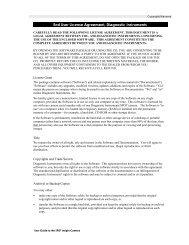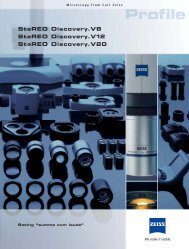optical interference filters - SPOT Imaging Solutions
optical interference filters - SPOT Imaging Solutions
optical interference filters - SPOT Imaging Solutions
You also want an ePaper? Increase the reach of your titles
YUMPU automatically turns print PDFs into web optimized ePapers that Google loves.
Frequently Asked Questions and Answers<br />
Q: What’s a safe Angle of<br />
Incidence (AOI) range for an<br />
<strong>interference</strong> filter?<br />
A: AOI is a critical parameter to consider<br />
when purchasing an <strong>interference</strong> filter. The<br />
primary effect of an increase in the AOI on<br />
an <strong>interference</strong> coating is a shift in spectral<br />
performance toward shorter wavelengths.<br />
That is, the principle wavelength of the<br />
filter decreases as the AOI increases. A<br />
typical <strong>interference</strong> filter will exhibit only<br />
minor changes in performance with a<br />
tilt of up to 10°. However, for certain<br />
narrowband <strong>filters</strong> and transition edges<br />
of dichroics, this slight shift may cause<br />
dramatic performance changes. For advice<br />
on how tilt affects performance please call<br />
one of our engineers.<br />
Q: Would a dichroic have better<br />
reflection/transmission in S or P?<br />
A: Simply put, reflection is better in S<br />
polarized light and transmission is better in<br />
P. This characteristic is most pronounced<br />
at the transition edge, where the dichroic<br />
is going from high reflection to high<br />
transmission.<br />
Q: Why are blocking specs so<br />
critical?<br />
A: Most people know where their signal<br />
of interest lies, but sometimes do not<br />
consider potential sources of “noise”. This<br />
“noise” could be autofluorescence from<br />
the sample, or the signal from another<br />
fluorophore, or even energy from their<br />
light source. Blocking is the feature of a<br />
filter that attenuates this unwanted energy<br />
and permits the energy from the signal<br />
of interest to pass through. Using <strong>filters</strong><br />
designed to block unwanted signals can<br />
improve signal-to-noise and robustness of<br />
the data.<br />
Q: I want sharp edges, are the 3rd<br />
Millennium <strong>filters</strong> suitable?<br />
A: 3 RD Millenium <strong>filters</strong> are manufactured<br />
using Omega Optical's ALPHA technology ,<br />
which produces very steep edges, capable<br />
of handling most application needs.<br />
Standard 3 RD Millenium <strong>filters</strong> utilize an<br />
ALPHA Gamma edge that has a 3% slope<br />
factor. This means that the filter’s cut-on or<br />
cut-off edge will go from 50% peak height<br />
to OD 5 by the value: 50% peak height<br />
wavelength x (0.03).<br />
3 RD Millenium <strong>filters</strong> can also be<br />
manufactured with an ALPHA Epsilon<br />
edge. This filter has a 1% edge factor and<br />
thus will go from 50% peak height to OD 5<br />
by the value: 50% peak height wavelength<br />
x (0.01).<br />
Q: Do my excitation and emission<br />
<strong>filters</strong> need to transmit at the<br />
peaks of a fluorophore’s absorption/<br />
emission probability curve?<br />
A: Not necessarily. Although it is usually best<br />
to encompass as much of the probability<br />
peaks of a fluorophore as possible,<br />
sometimes other limiting factors preclude<br />
this solution. One example is a sample with<br />
multiple labels that have significant overlap<br />
of their emission peaks. In this case, moving<br />
the emission filter off the longer wavelength<br />
fluorophore’s emission peak can improve<br />
signal discrimination.<br />
Q: How do I clean my <strong>filters</strong>?<br />
A: If dust and debris are the primary<br />
contaminants, <strong>filters</strong> can usually be<br />
sufficiently cleaned by using dry air (such<br />
as a puff from a pipet bulb) or compressed<br />
air (not canned air). If the <strong>filters</strong> have oily<br />
substances that cannot be easily removed,<br />
either acetone or isopropanol can be used<br />
with a soft, lint free applicator, such as a<br />
Q-Tip or soft lens paper.<br />
Q: What does the arrow on the side<br />
of a filter indicate?<br />
A: Omega Optical <strong>filters</strong> should be oriented<br />
with the arrow pointing in the direction of<br />
the light path. In other words, the arrow<br />
points away from the light source and<br />
towards the detector.<br />
Q: Can I use an excitation filter as<br />
an emission filter and vice versa?<br />
A: Though generally not recommended,<br />
Omega's QuantaMAX product line is<br />
manufactured on single glass substrates<br />
with extended blocking on both excitation<br />
and emission <strong>filters</strong>, thus allowing for an<br />
excitation filter to be used as an emission<br />
filter, and vice versa.<br />
Note: QuantaMAX fluorescence <strong>filters</strong> are<br />
designed to function optimally as part of a<br />
filter set. Using a specific filter outside of<br />
the intended set may provide acceptable,<br />
though not optimal, performance.<br />
Q: Can I use a dichroic from my<br />
microscope in a flow cytometer for<br />
the same dye?<br />
A: Generally, no. Flow cytometers are<br />
designed to use dichroic beamsplitters<br />
which have different specifications than<br />
a fluorescence microscopy dichroic<br />
beamsplitter. When inquiring about a<br />
particular dichroic not sold as part of a filter<br />
set, you should always specify its desired<br />
application.<br />
Q: I’m using a filter set to image<br />
Cy5®, but I don’t see any image on<br />
the screen and I know I have enough<br />
dye loaded. Is the filter working<br />
properly?<br />
A: Probably, yes. Cy5 ® is a fluorophore<br />
which emits at the far end of the visible<br />
spectrum (peak at 670nm), this can make<br />
viewing it through the eyepiece of the<br />
microscope very difficult and typically a<br />
B/W CCD camera or PMT is needed to<br />
detect it. Many CCD cameras come with IR<br />
blocking <strong>filters</strong> housed in front of the chip<br />
and attenuate light from 650 nm upwards.<br />
This effectively blocks signal from Cy5 ® and<br />
similar dyes from reaching the detector.<br />
Consult your camera’s manual to see if the<br />
filter can be switched off line or removed.<br />
Q: How thin can my filter be?<br />
A: 1 mm (in limited cases 0.5 mm), and<br />
when reflection is not a requirement. Filter<br />
coatings can "bend" substrate materials,<br />
so the thinner the substrate, the greater<br />
the chance for bending, which will distort<br />
images.<br />
112<br />
For current product listings, specifications, and pricing:<br />
www.omega<strong>filters</strong>.com • sales@omega<strong>filters</strong>.com<br />
1.866.488.1064 (toll free within USA only) • +1.802.254.2690 (outside USA)

















